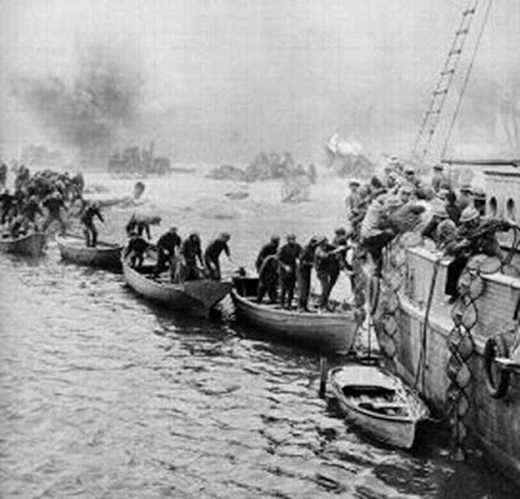Air Operations, Europe
Spitfires destroy 6 Me-109s and 6 Ju-87s over Dunkirk. Stukas pound British forces in the Calais Citadel. Berlin falsely claims Calais has fallen. During the night the RAF bomb railway targets in Rhineland.
[Atlantic
- The British anti-aircraft cruiser Curlew is badly damaged by German bombing in Ofotfjord and is run aground for a total loss. 10 of her crew are lost. The remainder are picked up by the British destroyer Beagle and taken to Harstad.
- The British tanker Oleander (7048t) is badly damaged by German bombing at Harstad. She is run aground on the 27th to prevent sinking. The crew is rescued.
- Sunk by German bombing at or near Dunkirk are the French auxiliary minesweeper Dijonnais (389t), the French steamer Saint Camille (3274t) and the French steamer Ceres (3073t).
- The Belgian dredger Volkracht IV (300t) is sunk on a mine in the Zeebrugge Canal.
Britain, Command
Gen John Dill becomes Chief of the British General Staff. His predecessor Gen Edmund Ironside takes over as Commander in Chief of Home Forces.
[Britain, Home Front
It is announced in London that due to enemy occupation of Holland and parts of Belgium and Northern France, children are to be evacuated from a number of towns on the east coast.
[Norway
The British cruiser Curlew is sunk by air attack of Harstad.
[Secret War
Adm Otto Schniewind, Chief of the German Naval War Staff, predicts: 'Evacuation of (BEF) troops without equipment... is conceivable by means of large numbers of smaller vessels... even from the open coast'.
[Western Front, Dunkirk
The position of the Belgian army is becoming increasingly grave. It is clear that it is unable to stay in the fight for much longer. The British forces are beginning to fall back on Dunkirk and in the evening the order is issued to begin Operation Dynamo, the evacuation from Dunkirk. Adm Sir Bertram Ramsay, who commands the Royal Navy forces based at Dover, is appointed to command the operation. A total of 861 ships and boats are involved in the evacuation. A total of 231 of the rescue vesses are sunk, mostly by the Luftwaffe, but German air strikes were restricted by bad weather and the tenacious fighters of the RAF. The scope of the operation is not made clear to the local French commanders at first and they feel, with some justice, that they are being abandoned.
Evacuation Begins |
 |
Hitler orders von Rundstedt to resume the advance by his armored forces. The German attack resumes trying to cut off the British and French forces around Lille. A desperate defense enables most of them to get away to positions nearer the coast. The German 6th Army launches a powerful assault on the Belgians holding the Allied left flank. The BEF sends reinforcements. The French and the Belgians withstand violent German attacks between Courtrai and Vanenciennes. The French recapture several bridgeheads over the Somme east of Amiens. The Belgian High Command tells the British and French that its army's situation is critical. The Belgian government asks King Leopold to leave his country (as the Queen of Holland and Grand Duchess of Luxembourg have done), but the King refuses. In the Dunkirk evacuation only a little is achieved with less than 8,000 men being landed in Britain. During the night Calais falls to the German 10 Pzr Div.[MORE]
[![]()
![]() |
| ![]()
![]() ]
]